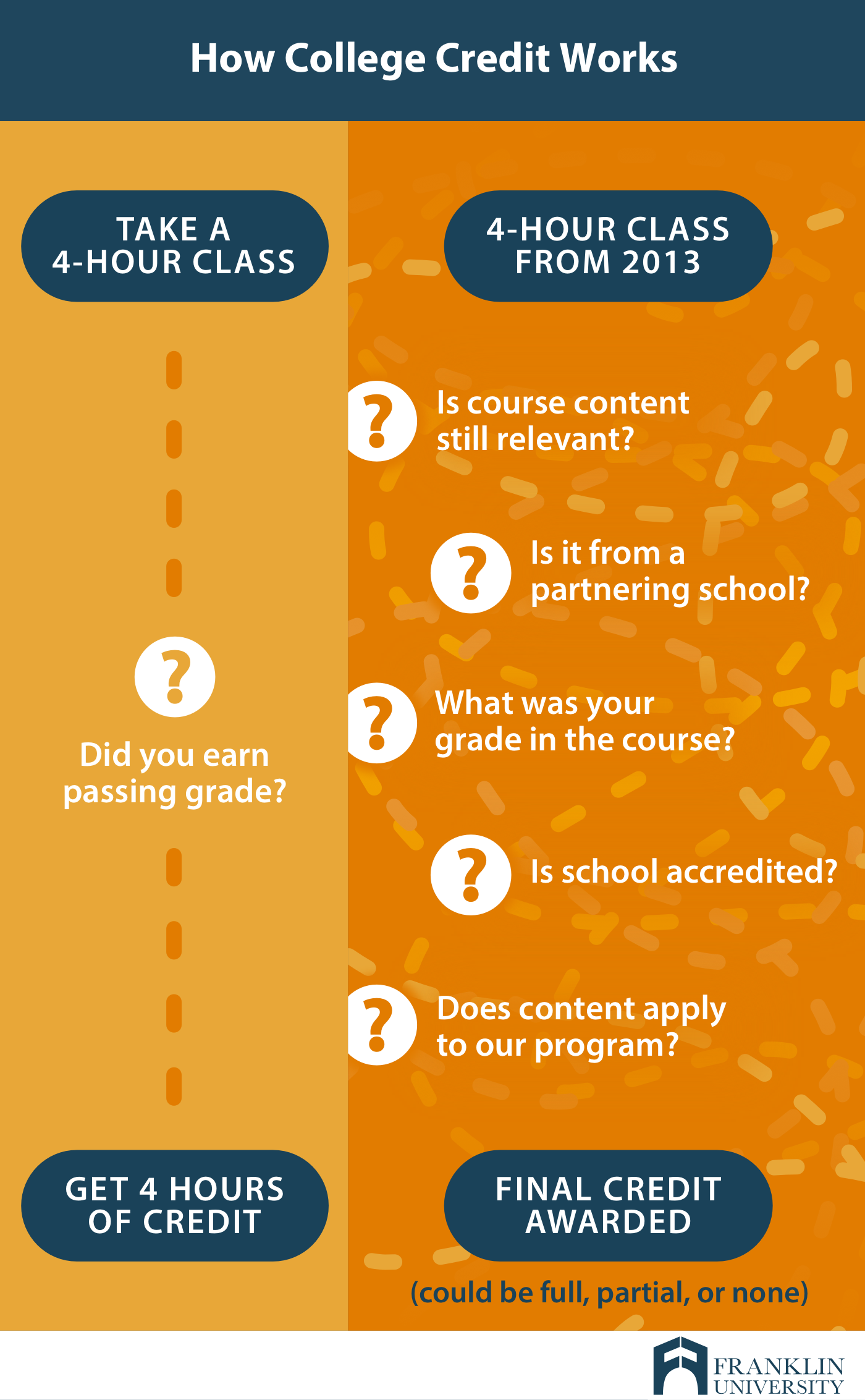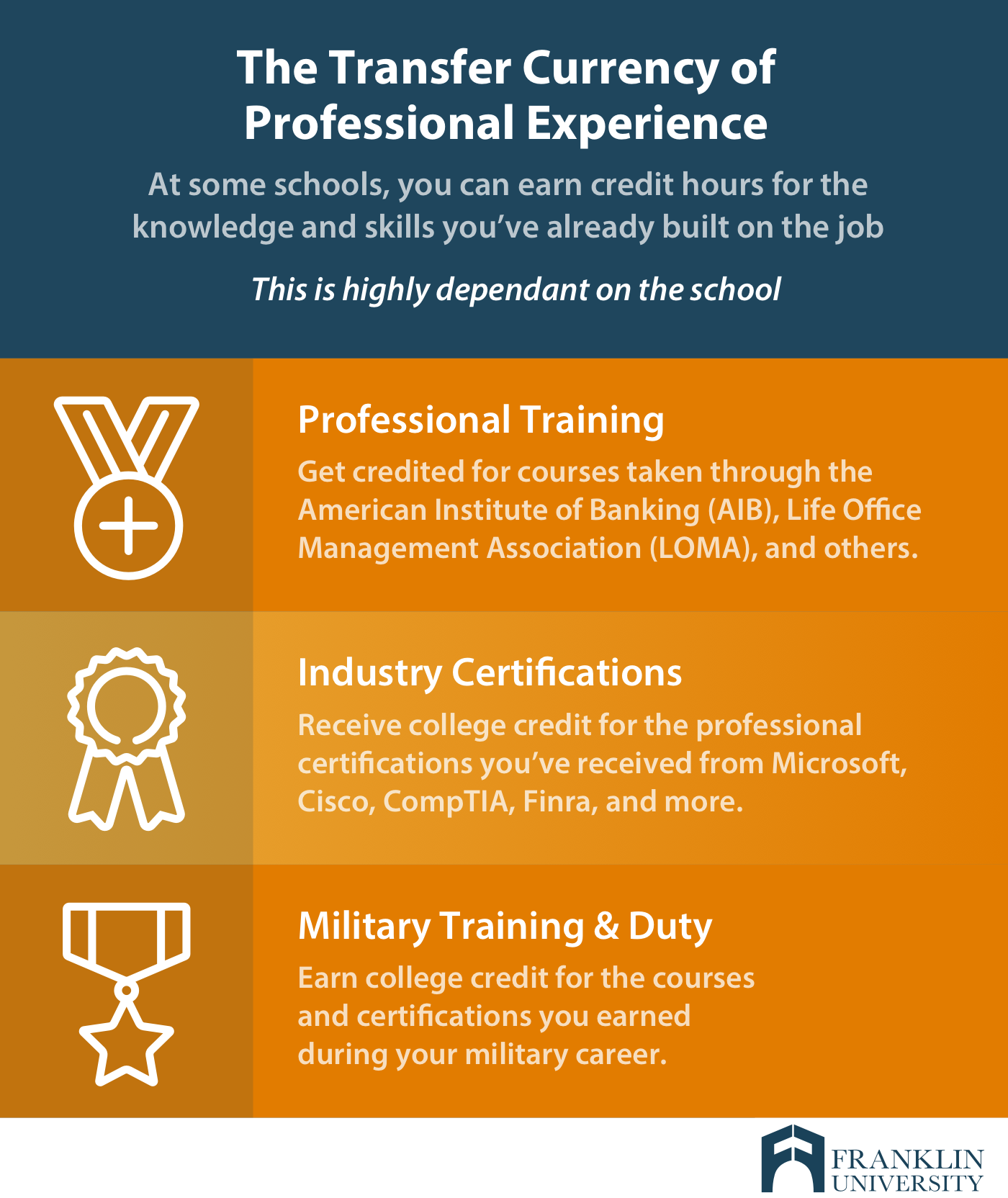Request Information
We're Sorry
There was an unexpected error with the form (your web browser was unable to retrieve some required data from our servers). This kind of error may occur if you have temporarily lost your internet connection. If you're able to verify that your internet connection is stable and the error persists, the Franklin University Help Desk is available to assist you at helpdesk@franklin.edu, 614.947.6682 (local), or 1.866.435.7006 (toll free).
Just a moment while we process your submission.

How to Transfer College Credit to Finish Your Bachelor’s Degree
You’ve completed some college courses, but not enough to get your degree.
Like many of us, life changed on you. Maybe you ran out of funding, had go back to work, or started a family. And although it’s been a while, now you are ready to go back and get that degree.
But how long will it take to complete your degree? Can you transfer any or all of those credits you earned back then? Is there a way to fast-track a new degree by using what you’ve already done?
The Subjectivity of Transfer Credits
Let’s start by discussing how the college credit system works.
For most bachelor’s degrees, you’ll need around 120 hours of coursework to graduate. Those hours accumulate one course at a time, with most courses being worth around 4 hours of credit.
When it comes to transferring credit, however, the school has discretion over whether it’s accepted as credit or not—and it can seem a little subjective and convoluted. A school may consider:
- The source of the existing credit—Was it earned from a local community college that has a partnering transfer-credit agreement in place or from a technical school with no affiliation?
- The accreditation of the institution—If the school is non-accredited, chances are the credits will not be accepted. Accredited schools have gone through rigorous efforts to ensure their coursework meets high educational standards.
- How well you did in the course—Some schools will accept a passing grade. Others demand a final grade of B or better.
- How old the credits are—Most “core classes” (like business math or psychology 101) are fairly standard courses and the content doesn’t change much over time. Some subjects have ever-changing standards, like computer coding, and are unlikely to be accepted over time.
- How relevant the credits are—An anatomy course from a previous nursing degree might be seen as relevant enough to qualify for credit toward a program in physical therapy. A bookkeeping course may not qualify as credit for introduction to accounting. The school has a fair amount of say in how relevant the old material is when compared with their current coursework.

The good news is that more of your old credit may transfer than you thought. In addition, you may discover new opportunities to earn credit based on your life and professional experiences. The truth is that many 4-year colleges are working harder toward helping busy adults earn a degree faster.
How to Find Out If Your Credits Will Transfer
The process of finding out if your credits transfer can be daunting. In the end, the only way to know for sure is to start the process.
- Step 1: Predict Eligibility. Some schools have online tools to help you understand how many of your credit hours may transfer. It’s just one of the ways that some schools are looking to help you with the transfer process, like this online transfer calculator.
- Step 2: Apply to the School. Transfer credit generally won’t be officially evaluated until you apply for admission. Applying may be easier than you think; some schools have made the application process to be online, fast, and free for undergraduate students.
- Step 3: Send Your Transcripts. After you’ve applied, ask your previously attended schools to send transcripts to the new school for evaluation. Contact your previous Office of the Registrar or Office of Records and ask specifically for an official, unaltered, sealed transcript to be sent directly to the new school. Keep in mind that some colleges and high schools may charge a minor processing fee ($3-10) when you request your transcripts. Whether you want the transcripts sent by mail or electronically, be sure to have the correct address.
- Step 4: Wait for Assessment. You should allow about 4 weeks to complete this process. Once complete, you will receive an email notifying you that your transcript assessment is complete.
- Step 5: Review Your Credit Evaluation. Most likely, you’ll be notified by email when your credit transfer information is ready to review. If you have any questions or concerns, contact your admissions advisor for further explanation.
But what happens if you discover that some of your credits won’t transfer? Then what? Well, resourceful student that you are, you’re going to discover that you just might have some options.
Accelerate your completion time and lower your total tuition cost at every academic level. Download this free guide for tips on maximizing your transfer credit.
3 Ways to Get Credit for The Work You’ve Already Put In
It can seem daunting to have so much time and money riding on these decisions. Here are some important tips to get the most credit when going back to school.
- Choose a Transfer-Friendly Program. As you consider which college you’ll attend to finish earning your degree, you’ll notice that some schools have a more generous acceptance of previously earned credits. Generally speaking, colleges want to help you get into their program, but they also want to ensure your previous learnings have you standing on solid ground when you arrive. Just because a school accepts more of your credits than another doesn’t mean they are comparatively soft or less rigorous. It merely means they have determined the coursework in question is an acceptable proof of your knowledge.
- Be Sure to Submit All Your Transcripts. Maybe in high school, you took an advanced placement (AP) class and exam that could transfer as credit. Some students might forget to submit old transcripts from a year or two they took at community college, where they might find hidden credit in general education courses. In the end, each school sets its own standards, so you’ll need to confirm by actually starting the process.
- Work with Your New Admissions Advisor. You might be surprised at how resourceful your new school can be when it comes to partnering with you. Talk with your advisor. Perhaps he or she knows of a similar degree with fewer credit requirements. Maybe you’ve overlooked some educational experience that qualifies as credit. You’ll never know until you try. Be proactive and ask for advice.
Get Even More Credit for Experience
There may be additional options to earn credit for your previous work experience or background. Not all programs provide these options, but some schools will work with you to apply real-life experience to classroom credit.

- Industry/Professional Certifications Can Translate into College Credits. Did you know that it’s possible to get college credit now for what you’ve already done, including professional coursework and certifications? Not every college offers it, but some will consider your prior work and professional experience as proof of your knowledge and competence in a subject—worthy even of awarding you college credit.
- Your Military Training Could Count as Credit. Ask your school if they have a way to offer credit for your military experience. Some will and some won’t, but it’s worth asking. The schools that do offer credit to military members will likely need the courses to be verified with a JST (Joint Services Transcript).
- Test Out of Courses to Reduce Remaining Credit Hours. You don’t always need course credit to get course credit! You may also have an option to test out of some required courses. There are nationally recognized testing companies, for example, CLEP and DSST. They offer tests in dozens of subjects, like financial accounting, business management, and introductory psychology. When you pass, you've shown that you're proficient in the topic and you've earned the right to the relevant college-level credits. The exams cost around $100 to take, but passing could save you much more in terms of tuition and time.
Before you sign up for an exam, be sure that your school accepts that testing company’s results as proof that you’re proficient in the subject and worthy of college credit. It’s important to note that not all colleges and universities accept CLEP or DSST. Talk with your school’s academic advisor to be sure.
Find Hidden Transfer Credit Opportunities at Your Chosen School
All schools are not created equal. With a little research, you’ll quickly find that credit transfer opportunities are more robust and creative in some institutions. Here are a few additional opportunities to consider.
- Ask if your school offersPrior Learning Assessment (PLA) Portfolio Services. PLA is one way for a school to put a value on your experience, previous learning, and current knowledge. Consider it like a standardized review of your on-the-job experiences knowledge, one that could lead to transfer credits awarded to you, shortening the time and tuition it takes to earn your degree. Franklin University is one school that offers this standardized review--where you could earn college credit for what you already know.
- Ask about old non-STEM courses. STEM courses (science, technology, engineering, math) typically expire within 10 years because the course content must be updated to meet new, current standards of knowledge. (For example, computer science changes rapidly and a course from 2005 would be mostly obsolete.) However, there are some “core” courses with content that is mostly evergreen: subjects like public speaking, general psychology, composition, and statistics. The best way to know what will transfer is to work with an admissions counselor or the university’s registrar.
- Just Ask. The only way to find out all of the opportunities at your school is to ask specific questions.
Find Out How Much Credit You Can Carry Over
As you begin learning about your transfer prospects, a good place to start is online. With a quick search, you should be able to find some helpful credit-transfer tools out there. For instance, try this credit estimator tool, which calculates the credits you can transfer and how much time and tuition those credits will save you.
Once you get started, you’ll get a feel for how much of your previous efforts may qualify as credit. Then you can meet with your admissions advisor with more information and confidence.





